#Clark Global City
Text
Global Peace Festival 2022


12/03/22
Thanks for the message Catriona! Tagos to my bones ang inyong message. Haha
Sulit naman yung struggles ko papunta na naka 3 grab drivers ang nag cancel sakin at nakaka frustrate lang. Nung pang apat sabi ko pag ito nag cancel pa, di na talaga ako tutuloy. Hirap mag commute mag isa tapos introvert ka. Yung gustuhin mo nalang maligaw kaysa magtanong hahaha. Tapos ang pauwi din struggles din may jeep, bus pero punuan. Good thing may mga angkas driver with reasonable price naman kaya pinush ko na. Si kuyang driver naman ang daldal sa byahe tas nagpapicture sakin after ako ma drop off remembrance daw. Papakulam pa ata ako or required ba talaga sila mag picture with their passengers for documentation purposes or waaaht?
Big achievement na sakin 'tong pumunta ng ganitong events mag isa na usually pag ganito halos lahat may kasama.
Sobrang saya naman and I love how this movement gather youths, young leaders and all to encourage that we can do more, we are qualified to do something that can change people's lives. And also one family under God.
Less pictures/vids lang talaga and ni wala akong selfie during the event hahahaha sobrang inenjoy ko yung moment na andun ako.
Thanks also Autotelic! Kung di dahil sa inyo di ko malalaman tong event na to and I'm so happy na napanood ko kayo live. Ang lalayo kasi ng mga gigs nyo kaya thankful akong napunta kayo dito ^^
Cheers to more events like this! I see it coming :)
#Peace through music#Global peace#Global peace festival 2022#GPFestival2022#Photo#Autotelic#Clark Global City#litrato
2 notes
·
View notes
Text
Monterrace Suites Clark RENTAL
Discover luxury living! 🌟 Rent this furnished Studio Condo in Monterrace Suites, D'Heights Clark, for Php 30,000 monthly. Enjoy a balcony with an open space view. Your Clark retreat awaits! #ForRent #ClarkLiving
📌 S3 Tower, Monterrace Suites D’Heights Clark Freeport Zone Pampanga
Property Features
TYPE: Studio Condo📐 Floor: 40 sq.mStudio Unit, 1 Bath✅ 3rd Floor with Balcony facing open space
About Monterrace Suites
Monterrace Suites is a condominium development located in SunValley Clark adjacent to the Hilton Hotel and Casino. It offers condo units with good views, free parking space, and a quiet…

View On WordPress
#Clark#clark angeles city philippines#clark city#Clark Global City#clark intenational airport#Clark International Airport#Clark Pampanga#clark pampanga condo#condo clark#condo filinvest clark#d heights casino clark#d heights clark pampanga#dheights clark#Hilton Clark#hilton clark sun valley resort#Hilton Hotel Clark#marriott hotels clark freeport zone#mimosa condo in clark pampanga#monterrace#MONTERRACE SUITES#the sharp clark hills
0 notes
Text
RAKRAKAN FESTIVAL BAND LINEUP REVEAL AND EARLY BIRD PROMO
Are you ready for the ultimate music festival experience? Rakrakan Festival is here and it’s bigger and better than ever before! With an incredible lineup and an early bird promo that can’t be beat, this is the event you’ve been waiting for. Secure your tickets today and get ready to rock out! 🔥🔥🔥
Grab your chance to experience the ultimate music festival with Rakrakan Festival’s early bird…

View On WordPress
0 notes
Text
9Sail’s “Tip of the Law” podcast – “Harnessing Strategic Focus in Legal Marketing” with host Joe Giovannoli and guest yours truly … #lma24 #lmamkt
Thank you, 9Sail and Joe Giovannoli! Appreciate all you do for our profession and our community …
Join us on the latest episode of the Tip of the Law podcast, where host Joe Giovannoli sits down with Roy Sexton, Director of Marketing at Clark Hill and past president of the Legal Marketing Association – LMA International board. Discover how Roy’s unique journey from English major, theater…

View On WordPress
#9Sail#AI#analytics#animus Rex#ann arbor#Athena Dion#b. Riley Farber#Board Executive in Financial S#born this way#Capital Markets at LSEG; Jen Carter#CEO#Chair#Chief Financial Officer at NBCUniversal Studio Group; Caroline Farberger#clark hill#columbia city#comic books#Danna Tauber#David furnish#digital marketing#drag#drag is not dangerous#elton john#film review#florida#G7 Advisor at Caroline Farberger AB; and David Furnish#Global Head of Technology at Google; Avon Neo#han solo#Head of Global Markets Sales to Private Banks Asia at Nomura Singapore Limited; Adam Moysey#Holly Amatangelo#indiana
0 notes
Text
GRAMMY-Winning Legend Donald Lawrence/Yolanda Adams/Twinkie Clark Release New Song & Video: In Him There Is No Sorrow!
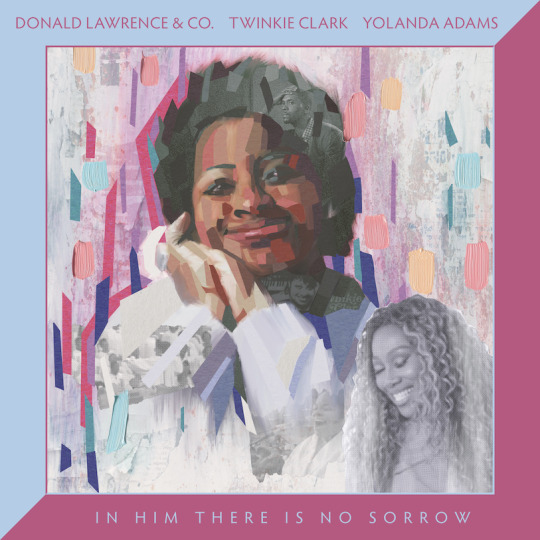
GRAMMY® Award-winning producer, songwriter, and recording artist Donald Lawrence has released a new single and music video, “In Him There Is No Sorrow,” honoring Twinkie Clark’s beloved song with a newly-recorded performance by Yolanda Adams. The chart-topping, legendary gospel maestro Lawrence has created this new single going out to gospel radio, teaming up with GRAMMY®-winning gospel legend Adams, in celebration of the artistry of pioneering GRAMMY®-winning gospel legend Twinkie Clark.
“In Him There Is No Sorrow” marks the first single release from Donald Lawrence’s upcoming tribute album highlighting Twinkie Clark’s early solo work with reimagined covers of her songs, whose talents as part of her family’s best-selling historic gospel group The Clark Sisters - as well as her work as a solo artist - remain a trailblazing influence on gospel artists today.
In the newly-released single and video from Donald Lawrence & Co., Yolanda Adams sings a powerful, modernized version spotlighting Twinkie Clark’s incredible songwriting that’s made it a classic. Keeping the message of the original song, the “In Him There Is No Sorrow” remake is an emotional tribute praising faith and God’s abilities to provide strength and lift us up throughout our lives. The music video made its broadcast premiere on the BET Gospel and BET Her channels on March 31st.
In his prolific career as a producer, songwriter, recording artist, music director and choir master, Donald Lawrence has garnered multiple awards, including GRAMMY®, Stellar, and Dove Awards, with numerous Billboard #1 singles and albums and over 200 million career streams. An integral force in crafting the sounds of The Clark Sisters and their solo endeavors in the past few decades, Lawrence was the music director on the record-breaking acclaimed 2020 movie biopic “The Clark Sisters: First Ladies of Gospel,” which was a ratings smash hit for Lifetime and the producer of the movie’s accompanying soundtrack.
He has collaborated with a diverse range of artists in gospel and R&B including Stephanie Mills, En Vogue, Mary J. Blige, BeBe Winans, Tasha Cobbs Leonard, Kirk Franklin and more, and been a leader in influencing the sound and visually-stunning performances of gospel choirs, performing with his groups The Tri-City Singers, and Company.
Among Lawrence’s acclaimed gospel albums and hit songs include “Encourage Yourself,” “The Blessing of Abraham,” “Deliver Me (This Is My Exodus),” and “The Gift.” Besides the new single “In Him There Is No Sorrow,” Donald Lawrence is also presenting an international choir gathering with the Edwin Hawkins Music + Arts Global conference, celebrating and elevating the longstanding artform of choir music worldwide, with the conference taking place April 27-29th, 2023 in London, England. More information on Music + Arts Global is available at: https://musicandartsglobal.com/.
Check out “In Him There Is No Sorrow” at the links below, available now on all streaming platforms.
Donald Lawrence & Co. / Twinkie Clark / Yolanda Adams - “In Him There Is No Sorrow” (Official Music Video):
https://youtu.be/ODxsOJ-rIQw
Donald Lawrence & Co. / Twinkie Clark / Yolanda Adams - “In Him There Is No Sorrow”:
https://DonaldLawrence.lnk.to/InHimThereIsNoSorrowPR
--- --- ---
To connect with Donald Lawrence, visit:
Website: http://donaldlawrence.com/
YouTube: https://www.youtube.com/channel/UChXKWkEyaUgQ-lfz45L4-uA
Instagram and Twitter: @donaldlawrence
Facebook: /DonaldLawrenceMusic
#Music#Gospel music#New Gospel Music#Donald Lawrence#Yolanda Adams#Twinkie Clark#The Clark Sisters#In Him There Is No Sorrow#Edwin Hawkins Music + Arts Global conference#Edwin Hawkins#BET Gospel#BET Her#Stephanie Mills#Kirk Franklin#mary j. blige#En Vogue#Tasha Cobbs Leonard#BeBe Winans#The Tri-City Singers and Company#naomi j richard#Naomi Richard#naomijrichard#RCV#Red Carpet View#KAZI 88.7#KAZI 88.7FM#The Voice of Austin
1 note
·
View note
Note
do you know any texts on the connection between fascism/the right and cleanliness/hygiene (purity) rhetoric? anything that goes a bit in depth on the topic?
Getting Under Our Skin: The Cultural and Social History of Vermin (2021). Sarasohn, Lisa Tunick. ISBN: 9781421441382
Dirt: New Geographies of Cleanliness and Contamination (2007). Campkin, Ben & Cox, Rosie (Eds.). ISBN: 9781845116729
The Sanitation of Brazil: Nation, State, and Public Health, 1889-1930 (2016). Hochman, Gilberto. ISBN: 9780252099052
Clean and White: A History of Environmental Racism in the United States (2015). Zimring, Carl A. ISBN: 9781479826940
Colonial Pathologies: American Tropical Medicine, Race, and Hygiene in the Phillipines (2006). Anderson, Warwick H. ISBN: 0822338041
Bacteriology in British India: Laboratory Medicine and the Tropics (2017). Chakrabarti, Pratik. ISBN: 9781580465908
The Great Hanoi Rat Hunt: Empire, Disease, and Modernity in French Colonial Vietnam (2018). Vann, Michael G. & Clarke, Liz. ISBN: 9780190602697
Soap and Water: Cleanliness, Dirt and the Working Classes in Victorian and Edwardian Britain (2010). Kelley, Victoria. ISBN: 9781848850521
Contagion: Disease, government, and the “social question” in 19th-century France (1999). Aisenberg, Andrew R.
Rome, Pollution, and Propriety: Dirt, Disease, and Hygiene in the Eternal City from Antiquity to Modernity (2012). Bradley, Mark & Stow, Kenneth R. ISBN: 9781107014435
Sanitizing South Africa: Race, Racism and Germs in the Making of the Apartheid State, 1880-1980 (2015). Fabio Terence Palmi Zoia. PhD. Dissertation, Indiana University. Available from ProQuest Dissertations & Theses Global. (1682266398)
there are also a few theoretical texts in social / cultural anthropology that will be frequent touchstones here, including norbert elias's 'the civilising process' (first published 1939) and mary douglas's 'purity and danger' (1966). i don't honestly think it's worth it or necessary to read these directly, both because they're dated in certain ways and because i think the historical studies are generally more useful. but you will probably notice these two texts & a handful of others repeatedly cropping up in introductory footnotes on this topic.
930 notes
·
View notes
Text

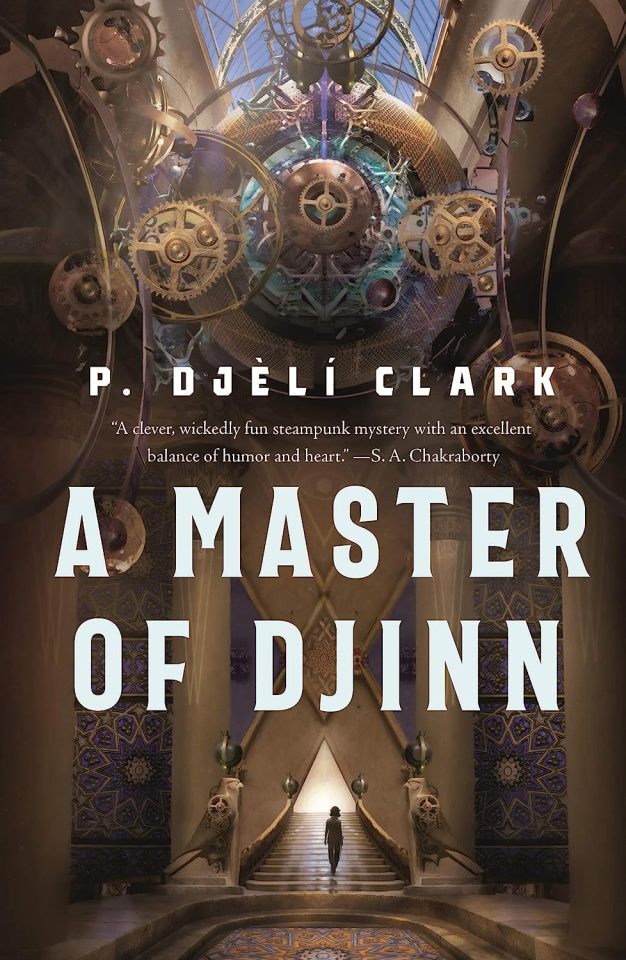
A Master of Djinn by P. Djèlí Clark
Cairo, 1912: Though Fatma el-Sha’arawi is the youngest woman working for the Ministry of Alchemy, Enchantments and Supernatural Entities, she’s certainly not a rookie, especially after preventing the destruction of the universe last summer.
So when someone murders a secret brotherhood dedicated to one of the most famous men in history, al-Jahiz, Agent Fatma is called onto the case. Al-Jahiz transformed the world 50 years ago when he opened up the veil between the magical and mundane realms, before vanishing into the unknown. This murderer claims to be al-Jahiz, returned to condemn the modern age for its social oppressions. His dangerous magical abilities instigate unrest in the streets of Cairo that threaten to spill over onto the global stage.
Alongside her Ministry colleagues and her clever girlfriend Siti, Agent Fatma must unravel the mystery behind this imposter to restore peace to the city -or face the possibility he could be exactly who he seems…
Genres: fantasy, historical, steampunk, romance
Order from Blackwell's here and get free worldwide shipping!
92 notes
·
View notes
Text
okay now that maws has officially introduced the evil alternate superman concept into the show I think it’s necessary to point out that across nearly every dc media revolving around Superman going rogue (not including ones where his upbringing is changed) the tipping point for his every downfall is almost always the death of Lois Lane.
Superman The Animated Series - Brave New Metropolis - Lois is doing a story on Intergang and getting too close to exposing them, so they bomb her car. Clark takes this as a realization that he’s fighting a war, and so has to take extreme measures to protect people; these extreme measures include teaming up with Lex Luthor for the sake of his vast resources and establishing a dystopian police state within Metropolis, however it’s important to note that Luthor abused his newfound authority to that dystopian extent, and Clark was genuinely unaware of the city’s true conditions.
Injustice - The Joker tricks Superman into killing [a pregnant] Lois and destroying Metropolis by detonating a nuclear bomb she is strapped to. Superman goes mad with grief and rage, kills the Joker in that infamous fist-through-the-chest-heart-ripping panel, and continues to slowly deteriorate into an amoral dictator over the course of five years. Eventually he establishes a borderline-fascist regime called One Force Earth, ironically intended to “enforce global peace,” but at the cost of the entire world’s personal freedoms (STAS also had an episode about this, featuring Mala and General Zod as the dictators in question).
MAWS is heavily focused on Clark and Lois’ relationship and his status as an alien as elements of his becoming Superman–and given that we’ve already been shown glimpses of the multiverse, alternate Super-tyrants, and an entire legion of Loises who more or less survived their respective Clarks, I think it’s very possible that some of the Soups we see in Mxy’s orb are Supermen who’ve either lost their Loises or their upbringing with the Kents—Supermen who have utterly lost or utterly lacked the very elements that this show emphasizes as being what makes Clark who he is, and I think it would add so much more tension between Clark and Lois and the rest of the world to know that their safety and his sanity basically hinges on this one woman he’s fallen into major puppy-love with.
#I LOVE CLARK AND LOIS SOOOOO MUCH YOU DONT UNDERSTTAAANBBDDDD#HE LOVES HER SO MUCH IT MAKES ME SICK#maws#maws spoilers#my adventures with superman#superman the animated series#evil superman#injustice#injustice gods among us#injustice superman#brave new metropolis#lois lane#clark x lois#clois#clark kent#dc#dc superman#dc injustice#not to be yearnful but characters who love somebody so much they instantly become insane over it are my favorite full course meal#tryna slide jack kline into this like he obliterated his own soul and slowly cooked a man to death bc his dad vaguely suggested wanting it#and he went fully psychotic with grief over killing his grandmother to the point of using necromancy to bring her back and fix it ..#twirls hair#there’s also Smallville Red K Clark who basically got high to cope with Lana breaking up with him but I don’t think that counts#it’s kind of lame actually im sorry
157 notes
·
View notes
Text

So @captainlordauditor had this in their response to a different post and mention of Marv Wolfman has triggered me. Because I was just thinking about how serial fiction works and how if you're working with serial fiction (comic books, soap operas, movie franchises) one of the things you need to remember is DON'T BREAK THE PLAYGROUND.
Example: In the DC universe (the DC universe of your imagination, not the official DCU of whatever some executive considers canon this week) Metropolis and Gotham are both considered stand-ins for New York City. They feel different, but they're both stories about life in a big US city. This works fine as long as you don't have an actual NYC in your DC universe. Do you prefer to imagine Metropolis as New York? There are a couple of easy places to put Gotham where it's close enough to visit but not so close that you wonder why Superman doesn't take fifteen minutes to clean up Gotham's streets. Want to imagine Gotham in the place of New York? Again, you can imagine Metropolis as close by but not so close that Bruce Wayne could just drive by and kick Lex Luthor in the nuts.
DAILY PLANET ONLINE EDITION
HEARTWARMING: WORLD'S ONLY BELOVED BILLIONAIRE TURNS GLOBALLY HATED ASSHOLE INTO SOPRANO
But then Marv Wolfman drops actual real NYC into the DC Official Canon, and now Metropolis and Gotham can't be New York. New York exists. You can't imagine Metropolis as New York even though the writers and artists blatantly intended it to be so (Aerial shots of Metropolis used to straight up copies of the NYC skyline minus a couple of specific buildings). It has to fit into a much more limited space. Same with Gotham. Suddenly you have two fictional cities that are supposed to have populations in the millions that need to fit somewhere around a similarly large real city. It limits the fictional universe and raises questions that don't really help the story.
It also means that Clark Kent could plausibly take an hour to drive to NYC, interview the Titans, and drive back in time for an afternoon meeting with Perry White. Why doesn't Superman fly in and beat the crap out of Deathstroke for annoying Nightwing, Supe's favourite nephew? Batman can take his plane and fly to New York in fifteen minutes. Shouldn't Wayne Enterprises have offices in Manhattan?
Throwing New York into DC didn't add anything new, or solve any story problems. Gotham and Metropolis had all the New York the stories needed. But it limited where readers could imagine their versions of Metropolis or Gotham to be. Marv Wolfman subtracted from the possibilities of the DC universe. And a lot of his writing did that, taking away possibilities that other writers could have used. Crisis On Infinite Earths was rampant vandalism of the entire playground, not just one playset.
And then there's the whole Tara Markov debacle.
#in the bronze age metropolis was much more new york than gotham ever was#gotham felt older and more worn than metropolis#not the urban death zone it has since become but just a place whose best years are behind it
66 notes
·
View notes
Text

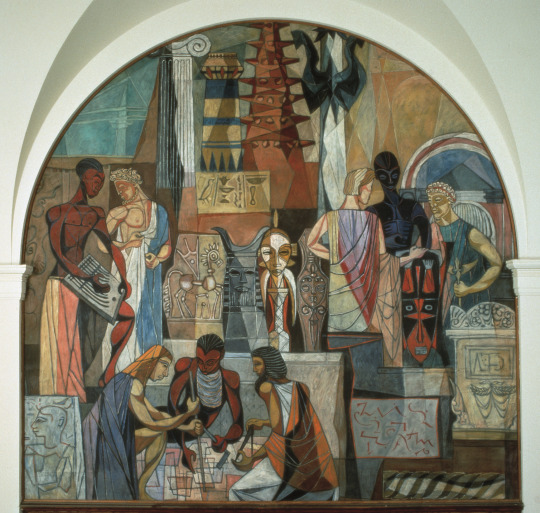
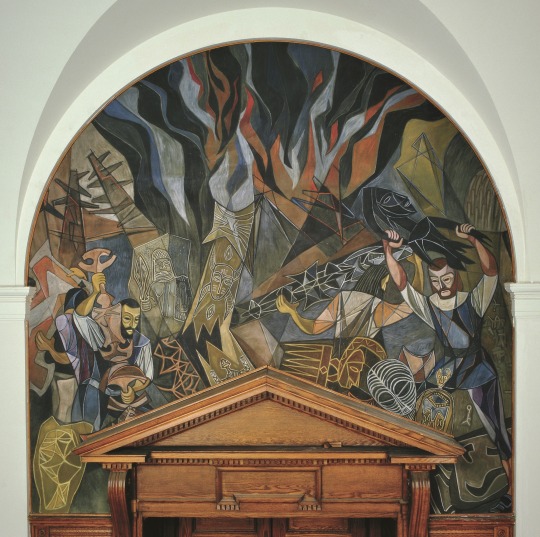
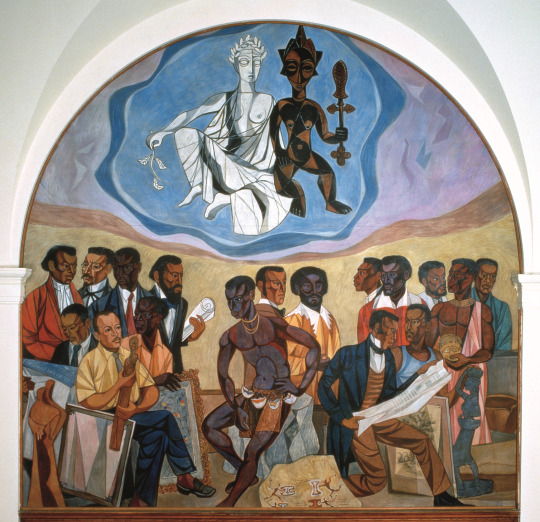

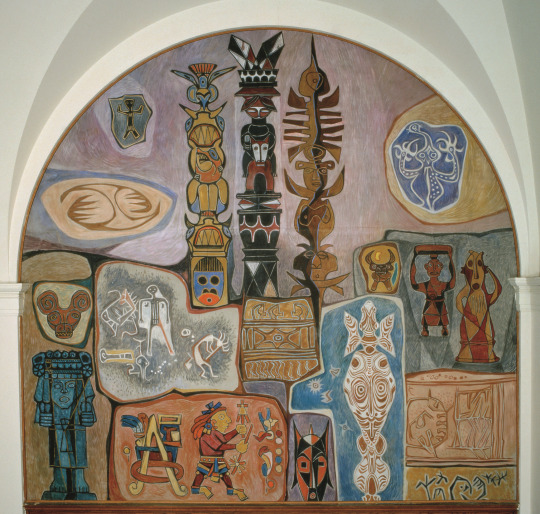
The Art of the Negro Murals
Housed in the atrium of Trevor Arnett Hall, the Art of the Negro mural series was painted by Hale Aspacio Woodruff (1900-1980) and consists of six, 12 x 12 foot oil on canvas panels. Woodruff, founder of the Atlanta University art department and permanent collection, painted the murals between 1950 and 1951. Woodruff aspired to providing the university community with a global narrative on the cultural history of Africans in the Americas. Referring to his rationale for painting the murals, Woodruff stated:
"It portrays what I call the Art of the Negro. This has to do with a kind of interpretive treatment of African art. . . . I look at the African artist, certainly, as one of my ancestors regardless of how we feel about each other today. I’ve always had a high regard and respect for the African artist and his art. So this mural, . . .is for me, a kind of token of my esteem for African art. One of the motivations again for doing these would be these murals would deal with a subject about which little was known—art and also among Negroes, there was little concern about our ancestry. Then I took the idea that art, being a little known subject, would attract the curiosity and attention of young people, as well as older people, toward further study and in that way the murals would have educational value. I thought also that the unusual subject matter would be timeless in a sense that the arts are always timeless."
Although Woodruff proposed to paint the murals after completing the Amistad mural series at Talledega College in 1939 and conferring with the Mexican muralist Diego Rivera, Atlanta University did not grant him the opportunity until 1950. By this time he had relocated to New York City and joined the faculty at New York University. Hence, the murals were painted in his New York studio. Woodruff declared them to be the best of all his murals.
Courtesy of Clark Atlanta University Art Museum
#social realism#african american art#hale woodruff#murals#early Indiana art#Indianapolis#Herron school of Art
40 notes
·
View notes
Text
Speaking exclusively to DailyMail.com about the budding romance, team CEO Clark Hunt's daughter Gracie Hunt gushed over the pair, saying: 'Travis and Taylor are definitely a power couple we can all cheer for! Taylor Swift's music has touched the hearts of millions (mine included) and Travis is a great guy.'
'Taylor's massive following spans across continents, and her fans are known for their unwavering support,' the influencer and philanthropist gushed.
'With Travis' undeniable talent, and Taylor's massive global fanbase, I hope that the Swifties will join Chiefs Kingdom in cheering for the red and gold.'
Having watched Taylor's tour performance at the stadium just months before, Gracie admitted it was a joy to see that star return to the venue to support the team.
'I learned that she would be attending the morning of the game and was absolutely thrilled to have her back to GEHA Field at Arrowhead Stadium after watching her rock the Eras Tour stage there this July', she concluded.
27 notes
·
View notes
Text
Airto Moreira & Flora Purim— Airto & Flora - A Celebration: 60 Years - Sounds, Dreams & Other Stories (BBE)
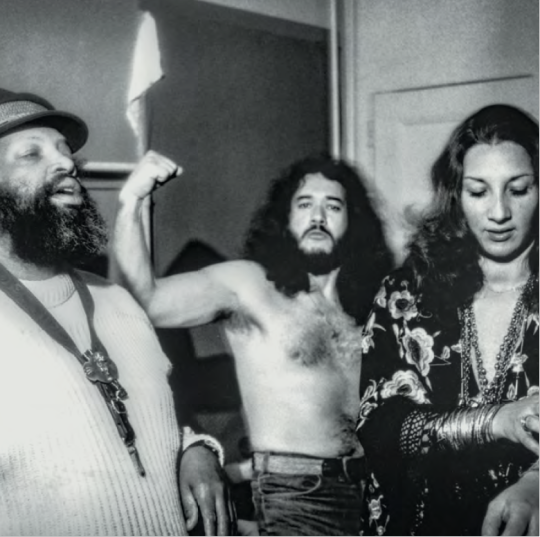
This massive compilation tracks the intertwined careers of two pivotal figures in fusion jazz, offering three hours of music from pioneers Airto Moreira and Flora Purim.
Though both Brazilian, the two came from starkly different backgrounds, Moreira from the rural hinterlands in the country’s far south, Purim from a cultured Jewish family in cosmopolitan Rio de Janeiro. Moreira was famously self-taught, drumming for the first time as a young teenager when a travelling samba band was missing a percussionist (he did well). Purim learned music from her pianist mother and a large collection of jazz 78s, then trained on the guitar with bossa nova master Manoel da Conceição. The two met when Moreira’s Sambalanço travelled to Rio and Purim sat in with the band in 1965. The outfit, slightly reconfigured as the Sambrasa Trio, became the pair’s first collaborative project together.
Purim left Brazil in 1968, fleeing a repressive military government. She connected with jazz players—Thelonius Monk, Wayne Shorter, Carmen MacRae, Joe Zawinul, Cannonball Adderly and Stan Getz—soon after her arrival in New York City and by 1969 was touring Europe with Getz. Moreira followed her to the States in 1969, arriving in New York, then flying to join her in Los Angeles. In 1970, he was invited to play with Miles Davis, who was then beginning to incorporate global sounds into his music.
Purim was arrested on drug charges in 1971, in an ill-advised attempt to raise money for a musician friend Hermeto Pascoal. She went to prison in 1974, just as her career was starting to take off. She learned that she had been named Downbeat’s Female Jazz Vocalist of the Year for 1974 while in jail. She was released in 1975. Afterwards she and Moreira connected with Chick Corea and joined Return to Forever.
It’s an extraordinary story, but despite the tumult both artists remained productive. Purim and Moreira released a string of albums together, with Purim often singing on Moreira’s releases and Moreira playing percussion on hers. BBE’s retrospective includes music released from 1964 through 1996, from earthy, percussion-heavy samba to cerebral fusion jazz anthems to airy new age meditations.
What strikes you first is that Purim and Moreira were very different artists. Purim’s high, extraordinarily agile soprano put a cool, sophisticated gloss on everything she touched, while Moreira’s best work was gutsy, visceral and celebratory. Together, though, they had an undeniable chemistry. “Andei” from Moreira’s 1970 debut Natural Feelings, for instance, melds the swaggering, sauntering exuberance of Moreira’s percussion with Purim’s note-perfect buoyancy. “Light as a Feather,” perhaps Purim’s best known song and the title track to the 1970 Return to Forever album, follows silky smooth, nearly disembodied vocals through gnarly thickets of improvised sax, keyboards, bass (that’s Stanley Clarke) and, of course, percussion. “Oh Sonho (Moon Dreams)” incorporates some of Purim’s most angelic, inhuman singing ever (and that’s saying a lot), and it comes from Moreira’s psychedelic samba-jazz masterwork Seeds on the Ground.
Moreira’s latter work turns fractious and lo-fi, and indeed, the 1990s cuts included here—“Musikana,” “The Happy People” and “The Peasant Dance”—are among my favorites. Yet while punk-trained ears may balk at the glassy smoothness of, say, “Open Your Eyes You Can Fly,” there’s a lot of friction even in the interstices. Purim made Moreira’s grooves sound unearthly, and Moreira surrounded her with terrestrial warmth. It was a great partnership, one that has lasted 60 years and counting and that is very well documented here.
Jennifer Kelly
#airto moreira#flora purim#a celebration#bbe#jennifer kelly#albumreview#dusted magazine#bossa nova#jazz#fusion#brazil#miles davis#return to forever#Bandcamp
17 notes
·
View notes
Text


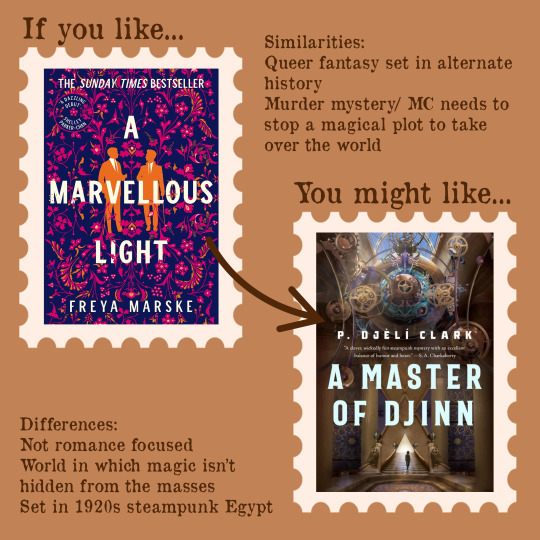
I finished A Master of Djinn by P. Djèlí Clark today and absolutely loved it.
Synopsis:
Cairo, 1912: Though Fatma el-Sha’arawi is the youngest woman working for the Ministry of Alchemy, Enchantments and Supernatural Entities, she’s certainly not a rookie, especially after preventing the destruction of the universe last summer.
So when someone murders a secret brotherhood dedicated to one of the most famous men in history, al-Jahiz, Agent Fatma is called onto the case. Al-Jahiz transformed the world 50 years ago when he opened up the veil between the magical and mundane realms, before vanishing into the unknown. This murderer claims to be al-Jahiz, returned to condemn the modern age for its social oppressions. His dangerous magical abilities instigate unrest in the streets of Cairo that threaten to spill over onto the global stage.
Alongside her Ministry colleagues and her clever girlfriend Siti, Agent Fatma must unravel the mystery behind this imposter to restore peace to the city -or face the possibility he could be exactly who he seems…
My Review
I highly recommend reading A Dead Djinn in Cairo, the 0.1 novella in this series, before starting this book! I skipped all the other novellas (though I'll probably get around to them when I can because I do love this universe), and didn't feel like it made a difference, but A Dead Djinn in Cairo is where Fatma and Siti meet, and the case they work on in that book is referenced multiple times in this book and has a huge impact on the overall plot - I would have been SO annoyed and confused by all those references if I hadn't read that book first.
That out of the way, I LOVE this book. The setting - alternate universe 1920s Egypt with some steampunk vibes to it - is SO cool, the main characters are fantastic, and the plot and mystery are really fun. I wouldn't try and sell this as a romance (the main couple are already together at the beginning of the book and the story doesn't revolve around them too much), but Fatma is a butch lesbian with hot femme fatal girlfriend Siti, and Fatma's friendship with Hadia, her new partner in the department, is a delight. I also think it had some fantastic things to say about colonialism, racism, colourism, slavery and xenophobia - often with a fantastic dry humour to it.
If you're a fan of A Marvellous Light's trilogy by Freya Marske I would highly recommend this to you.
#a master of djinn#p. djèlí clark#book recs#book recommendation#bipoc authors#queer books#lgbt books#sapphic books#booklr#reading#book review
10 notes
·
View notes
Text
My Adventures With Superman: Where do we go from here?
- This show takes on the Superman origin story but focuses on his beginning as a young adult superhero, which is different from nearly every other depiction. He seems just out of college, like he’s 20 or 21. This would mean everyone else in the DC universe is younger too.
- People often compare Bruce Wayne and Clark Kent on equal grounds, like they’re supposed to be the same age, so maybe they’re going to be? I don’t know if this show is ever gonna branch out and show other superheroes, other places besides Smallville and Metropolis, but it’s a fun thought exercise.
- So maybe Bruce Wayne is also just starting his Batman journey. He might be in Gotham in a self-made suit, like in Matt Reeves’ The Batman, or he might be training all over the world still. We know Bruce is a genius, so he can learn any subject he wants in a shorter time than normal, so he might’ve skipped college to travel the world right after high school, training with the best fighters and the League of Assassins and studying college-level texts on the side because he’s just extra like that. 18 at the beginning of his training, and there’s varying accounts of how long his training took. Some say 7 years, some say 12 years, and that makes sense.
- If we want reporter Clark Kent interacting with billionaire playboy Bruce Wayne at all, we can’t have them be the same age. So! I propose a future season where we finally get more superheroes interacting with Superman so he can feel less alone in the world. For that, Bruce Wayne would just be returned home after a 7 year absence learning abroad. He’d be about 4 years older than Clark, but he’d be perturbed by their lack of height difference. Bruce wants to start his crusade against the criminal underbelly of his hometown, Gotham City, but to have the perfect cover story he needs to play up the rich fail son front of Bruce Wayne, and he’s not pleased about this perceptive reporter from Metropolis who’s built like a brick shithouse. See, Bruce isn’t dumb, and he keeps up on the news, especially about global security threats. Bruce knows about Superman, and he has his theories, but he develops a new theory once he meets Clark.
- Wonder Woman is immortal but people don’t necessarily know that. Wonder Woman is an urban legend Clark learned about in history class when talking about World War 1, World War 2, all the biggest global conflicts in human history. A goddess who comes out of nowhere, saves the day, and disappears for decades at a time. Diana Prince, however, is a mild mannered museum associate. As an immortal warrior born of clay, she always looks like a woman in her upper 20’s and speaks like a woman who is centuries wise. She keeps to herself mostly, but she keeps close tabs on global security threats, like Bruce does. She knew as soon as Superman came on the scene that she didn’t need to get involved as much anymore. She barely held herself back on Zero Day because the US government was all over that, and it would’ve been too high profile if she’d been involved. It didn’t even last long enough for her to fly over to help.
- In the comics, Bruce Wayne adopts the newly orphaned Dick Grayson when he’s 27. That means if I start Bruce Wayne at 18, give him 7 years of training, making him 25, and make him 3 years older than Clark at the beginning of the story, meaning Clark is 22 when Bruce is 25, then he gets to be Batman for 2 years before running into Dick Grayson, 10 year old, and adopting him. Then, he gives Dick a few months of training before letting him become Robin, so we have 27 year old Bruce, 10 year old Dick, and 24 year old Clark.
- The comics also say Bruce was 34 when he adopts a 12 year old Jason Todd. That means Dick was Robin for 7 years before he and Bruce had a falling out and Dick went solo, becoming Nightwing. Dick and Jason should have a 5 year age difference, if Dick was 17 when Jason was 12. Then, there’s a bit of time fuckery when it comes to Jason because he dies and gets resurrected as Red Hood. Jason dies at 15, and gets resurrected in the Lazarus Pit 3 years after his death, making him effectively 18 when he comes back. Bruce would be 39 at the time of Jason’s death, and 42 at the time of Jason’s resurrection.
- Superman would be 31 when Dick becomes Nightwing and Jason becomes Robin, then 36 when Jason dies, then 39 when Jason comes back as Red Hood. I think that fits rather well.
- Tim Drake came along only a short while after Jason’s death, like a month or so, so Bruce is 39 when a 14 year old Tim Drake becomes the third Robin. Clark would be 36 at this point still. And then Tim becomes Red Robin at age 17, following in the footsteps of his hero Nightwing who also went solo at 17. Tim spends 3 years being Robin, meaning he spends the time Jason is dead being the third Robin.
- Comics place Bruce meeting his son Damian at age 43, meaning it’s a year after Jason comes back and suddenly he’s got a new son he never knew about. Talia left Damian with Bruce when Damian was 10, following the grand Robin-adopting tradition. This means Damian was conceived when Bruce was 33, right before he met and adopted Jason Todd. Superman becomes 40 at the point where Damian is adopted as the new Robin.
- With this timeline, it’s difficult finding spaces for Barbara, Stephanie, Cassandra, Duke, and all the other important Bat Family members, but it’s not impossible.
#I call Nightwing Tim’s hero because he was a fan of the Flying Graysons and that’s how he discovered Robin’s secret identity and Batman’s#maws#my adventures with Superman#dcau#dc#Superman#Batman#bat family#Wonder Woman#dc superheroes
7 notes
·
View notes
Text
“I still find that my theater training serves me probably better than anything else in my background. For me, future-ready is what I learned, preparing for performances, which is to do all of your homework behind-the-scenes.” Regan Robinson’s FutureFit with yours truly #lma24 #lmamkt
Regan Robinson and Roy Sexton, Director of Marketing at Clark Hill (ME!), delve into how his background in theater equips him with what’s needed to be future ready, and why his diverse passions provide a rich framework for seeing its possibilities. They explore the misconceptions about authenticity (which inherently promotes a long-term perspective), and how authentic leadership must be nurtured…

View On WordPress
#ann arbor#Athena Dion#Board Executive in Financial Services#born this way#Capital Markets at LSEG; Jen Carter#CEO#CEO/Chair of Rocket Entertainment Group/E#Chair#Chief Financial Officer at NBCUniversal Studio Group; Caroline Farberger#clark hill#columbia city#comic books#Danna Tauber#David furnish#drag#drag is not dangerous#elton john#film review#florida#futurefit#G7 Advisor at Caroline Farberger AB; and David Furnish#Global Head of Technology at Google; Avon Neo#han solo#Head of Global Markets Sales to Private Banks Asia at Nomura Singapore Limited; Adam Moysey#Holly Amatangelo#indiana#Investor#involve people#Jaime Baum#Jennifer Petrone Dezso
0 notes
Text
'Like countless moviegoers around the world, I’m a major fan of Christopher Nolan’s “Oppenheimer.” But like many of those who saw it, I wasn’t alone in having qualifications about the last part of the movie. For me, the first two hours of “Oppenheimer” were electrifying. I felt the kind of full-scale mind/soul immersion that’s the definition of what we look for when we go to the movies. But in the last hour, I experienced a certain falling-off quality. I was still involved, but less involved. As the film kept returning to the 1954 hearing that resulted in Oppenheimer losing his security clearance, with Oppenheimer in the hot seat being hectored by a team of interrogators led by Jason Clarke’s special counsel to the AEC, I thought, “Why are we still at this damn hearing?” I asked because I didn’t know.
Now I do. A month or so after “Oppenheimer” opened, I went back and saw it again, and this time my qualifications evaporated. I was just as electrified as I’d been by the first two hours — only now that sensation didn’t end. The feeling of immersion lasted all three hours, right to the final shot. I’m a bit embarrassed to say this, since it means admitting that I didn’t get the film right the first time; as much as I raved about it in my Variety review, I would now rewrite the last part of that piece. But I’m even more fascinated by why I missed a crucial element of the movie.
“Oppenheimer” presents its title character as a totemic figure, a daring, mysterious, endlessly complicated renaissance genius who rose to his moment by envisioning and overseeing the creation of the atomic bomb. Cillian Murphy, in his mesmerizing performance, endows Oppenheimer with an all-knowing aristocratic dandy swagger. He makes him a singularly charismatic figure, a wizardly idealist who conjures up an awesome power and then grapples with the consequences of his actions. And since it feels as if Oppenheimer, at that hearing, is being persecuted (to a large extent for his earlier Communist ties), it was hard to watch it without feeling like I was on his side.
The movie, however, is not on his side. Not really. In the last hour, it’s deeply critical of Oppenheimer — as critical, I would say, as any major Hollywood biopic has ever been of its subject. And this is the road I didn’t fully let myself travel down the first time I saw “Oppenheimer.” The last hour was trying to me because I was fighting what the movie was.
I can say, with some surprise, that the final hour of “Oppenheimer” is now my favorite part of the movie. It’s the most morally dramatic and hypnotic — the true inquiry into who Oppenheimer was, and why he’s a hero who will always have an oversize asterisk next to his name.
The first time out, I thought I was watching a drama about the creation of the A-bomb. But as captivating as all that is — the science-lab frenzy, the race against the clock, the thorny politics of life in the makeshift city that was set up in the Los Alamos desert — the process by which Oppenheimer and his fellow brainiacs transformed nuclear fission into a weapon capable of delivering a nuclear apocalypse is not exactly the stuff of spoiler alerts. They gathered; they devoted themselves; they wondered if they were going to set the global atmosphere on fire; they triumphed.
Since “Oppenheimer” is a movie with a built-in big bang, I spent a lot of that first viewing anticipating what the Trinity Test would look and feel like. I still think it’s the one disappointing aspect of the film. Nolan fragments the bomb detonation (glaring light, rising hellfire), and in doing so he somehow fails to channel its viscerally terrifying and unprecedented largeness. That kind of threw me off.
Was the building of the atomic bomb justified? “Oppenheimer” says that it absolutely was. The Nazis were working on their own bomb, and Oppenheimer, who was Jewish, very much saw his mission as an attempt to save civilization by winning a weapons race that, had the Nazis won it, might have resulted in a level of devastation beyond the unthinkable.
But was the dropping of the atomic bomb justified? Given that the Nazis had been defeated before the decision was made (by President Truman) to drop the weapon on Hiroshima and Nagasaki, a powerful case could be made that it was not. Should Nolan have depicted the effects of the bomb on the Japanese, as Spike Lee suggested this week? I think that would have made “Oppenheimer” a very different movie, and not necessarily a better one. I’m not here to rehash that debate, but I’ll point out that Nolan’s film features Oppenheimer, speaking to a roomful of his Manhattan Project colleagues, cutting to a kind of cosmic justification for dropping the bomb. He says, in essence, that it will act as an inoculation, forever scaring off the human race from using the bomb by demonstrating its deathly horror.
Perhaps he was right. But this was still Oppenheimer’s Faustian bargain. He convinced himself that dropping the bomb was justified, maybe even necessary, but in doing so he was also acting out of an elaborate and convoluted self-interest. On some level he’d invented a new toy and desperately wanted to use it. Though it wasn’t his decision to use it, he distanced himself from the horror of that decision.
The rest of the movie is about how the horror comes crawling back. I certainly saw elements of that the first time. But I what I missed, in my kneejerk-old-school-liberal way, is that the 1954 hearing runs on and on not because the film is trying to demonstrate that Oppenheimer was “persecuted.” As much as the Communist associations he had in the ’30s come into play, the point is not to depict the hearing as a McCarthyite smear (even though, in fact, it kind of was).
No, the startling thing about the last hour of “Oppenheimer” is that it features two characters who seem to exist almost entirely to prosecute and torment our hero, and in both cases what they say about him is right. “Oppenheimer” shows us how J. Robert Oppenheimer was not so much a victim of history, or of an oppressive U.S. government, as he was a defensive narcissist crusader who spent his final years using the trigger of his guilt to cover himself in a kind of grand delusion.
Robert Downey Jr.’s performance as Lewis Strauss, the former head of the AEC who becomes Oppenheimer’s antagonist, is a stupendous outpouring of extemporaneous verbal energy (the actor is even more commanding without his irony than he is with it). But because Strauss is the person who stabbed Oppenheimer in the back, I assumed, the first time I saw the movie, that Nolan figured he needed some sort of villain, and that the virulent, hawkish Strauss was it. Strauss certainly had petty personal motives; the film returns several times to the Congressional hearing in which Oppenheimer publicly humiliated him with a flippant comment about radioisotopes. Yet the reason that Strauss, in certain ways, comes close to dominating the film’s last hour isn’t simply because we’re watching a bureaucrat take his vengeance. It’s because Strauss is the one who understands, and articulates, a crucial element of the film’s verdict on Oppenheimer: that he was a brilliant and self-glorifying celebrity who forged a mythology around himself, one that extended into his very crusade against the weapon he’d created.
Oppenheimer was the scientist who let the nuclear genie out of the bottle, but after the war he devoted his life to essentially saying, “Let’s try to put it back in.” Never realizing that this was hypocritical and unreal. In public, he’d mocked Strauss, and it was Strauss’s sleazy double dealing that was on trial during his own 1959 Senate confirmation hearing for Secretary of Commerce — the other hearing that’s featured in the movie.
But the reason that Strauss is in the movie, and the reason Downey should win the Oscar for best supporting actor for his performance, is the fantastic fervor with which he rakes Oppenheimer over the coals. Just because Strauss is rather scurrilous doesn’t mean that he’s wrong; he’s the one who has Oppenheimer’s number. And so does Jason Clarke’s Roger Robb, the AEC attorney who, in one of the film’s most cathartic moments, gives a speech in the 1954 hearing that excoriates Oppenheimer for the hypocrisy of his position on the hydrogen bomb: his denunciation of it as a monstrously overscaled weapon — but talk about the wrong messenger! Oppenheimer’s A-bomb was already an obscenely overscaled monster.
Christopher Nolan, in that inquiring last hour, has written all this into the movie, not because he wants to damn J. Robert Oppenheimer but because he wants to take the full measure of a 20th-century visionary who charged into the creation of the atomic bomb as if it were the science project of a lifetime — which it was — but had the luxury of not fully thinking through the implications of his actions. By the time he thought them through, he’d turned his criticism of America’s nuclear policy into a grandly repressed apology. He used the nuclear debate, and even his own martyrdom, to justify himself. But the way the movie portrays this doesn’t make it an attack on Oppenheimer. It makes “Oppenheimer” a piece of history that’s also a human exploration of the most exhilarating honesty.'
#Oppenheimer#Christopher Nolan#Lewis Strauss#Robert Downey Jr.#Oscars#Cillian Murphy#Trinity test#President Truman#Jason Clarke#Roger Robb
7 notes
·
View notes